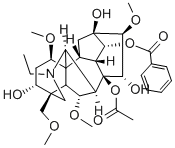아코니틴
|
|
아코니틴 속성
- 녹는점
- 200-205 °C (dec.)
- 알파
- D +17.3° (chloroform)
- 끓는 점
- 675.12°C (rough estimate)
- 밀도
- 1.2181 (rough estimate)
- 굴절률
- 1.6630 (estimate)
- 저장 조건
- Refrigerator
- 용해도
- Soluble in ethanol;
- 물리적 상태
- 백색 내지 회백색 분말.
- 산도 계수 (pKa)
- 5.88(at 25℃)
- 색상
- 하얀색
- 수용성
- 에탄올에 용해됩니다. 물에 거의 녹지 않음
- Merck
- 13,120
- CAS 데이터베이스
- 302-27-2
- NIST
- Aconitine(302-27-2)
안전
| 위험품 표기 | T+,Xi | ||
|---|---|---|---|
| 위험 카페고리 넘버 | 26/28-36/37/38 | ||
| 안전지침서 | 24-45-36-26 | ||
| 유엔번호(UN No.) | UN 1544 6.1/PG 1 | ||
| WGK 독일 | 2 | ||
| RTECS 번호 | AR5960000 | ||
| F 고인화성물질 | 10-34 | ||
| 위험 등급 | 6.1(a) | ||
| 포장분류 | I | ||
| 독성 | LD50 in mice (mg/kg): 0.166 i.v.; 0.328 i.p.; approx 1 orally (Dybing); also reported as LD50 in mice (mg/kg): 1.8 orally, 0.270 s.c.; 0.380 i.p.; 0.12 i.v. (Sato) |
아코니틴 C화학적 특성, 용도, 생산
개요
Aconitum plants (Wu Tou, Ranunculaceae family) have been widely used to treat various diseases, such as rheumatism, knee pain, herpes zoster, scabies, and other disorders in China for thousands of years. It was first described in Shen Nong’s Herbal Classic (the earliest classical work of Chinese herbs). Aconitine is the main active component in Aconitum plants.화학적 성질
Off-White Solid물리적 성질
Appearance: solid. Solubility: barely soluble in water and soluble in organic solvents such as chloroform or diethyl ether. Its solubility in water and ethanol are 0.3?mg/mL and 35?mg/mL, respectively. Melting point: 203–204?°C (397–399?°F; 476–477?K). Optical rotation:D+17.3°역사
Preparations of Aconitum roots are employed in Chinese medicine for analgesic, antirheumatic, and neurological indications. In the Ming Dynasty, Chinese people had extracted the aconitine from the Aconitum plants. Aconitine is synthesized by the Aconitum plants via the terpenoid biosynthesis pathway (MEP chloroplast pathway)용도
Neurotoxin. Activates tetrodotoxin-sensitive Na+ channels, inducing presynaptic depolarization, thus blocking the nerve action potential which, in turn, blocks the release of neurotransmitters and dec reases the end plate potential at the neuromuscular junction. Aconitine also blocks norepinephrine reuptake. In the heart, aconitine induces ventricular tachycardia after intracoronary injection. In c ultured ventricular myocytes, aconitine increases the duration of the action potential and induces the appearance of early after depolarization. Used in producing heart arrhythmia in experimental anim als.정의
ChEBI: A diterpenoid that is 20-ethyl-3alpha,13,15alpha-trihydroxy-1alpha,6alpha,16beta-trimethoxy-4-(methoxymethyl)aconitane-8,14alpha-diol having acetate and b nzoate groups at the 8- and 14-positions respectively.Indications
Aconitine was previously used as an antipyretic and analgesic. However, the clinical application of aconitine is limited by its high toxicity. Its lethal dose 50% (LD50) for mice is 1.8?mg/kg (orally) and 0.308?mg/kg (intraperitoneally).건강위험
Aconitine is among the most toxic alkaloidsknown. Toxic doses are close to therapeuticdoses, and in humans as little as 2 mgmay cause death (Ferry and Vigneau 1983).An oral lethal dose of 28 mg/kg has alsobeen recorded (NIOSH 1986). The toxicsymptoms at low doses may be excitement,drowsiness, and hypermotility. The first signof poisoning from ingestion is a tingling,burning feeling on the lips, mouth, gums,and throat (Hodgson et al. 1988). This isfollowed by nervous disorders, anesthesia,loss of coordination, vertigo, hypersalivation,nausea, vomiting, and diarrhea. Toxic actionsof aconitine are very rapid. The crystallineform of this compound is much more toxicthan the amorphous aconitine. At a lethaldose, death may result from cardiorespiratoryfailure. Procaine may be an effective antidoteagainst aconitine poisoning.Pharmacology
Aconitum was found to have neurotoxin. It could activate tetrodotoxin-sensitive Na+ channels, inducing presynaptic depolarization and blocking the nerve action potential and, in turn, blocking the release of neurotransmitters and decreasing the end plate potential at the neuromuscular junction. Aconitine was also found to block norepinephrine reuptakeIn the heart, aconitine could induce ventricular tachycardia. In cultured ventricular myocytes, aconitine could induce the appearance of early after depolarization by increasing the duration of the action potential.
Research with mouse nerve-hemidiaphragm muscle preparation found that aconitine at low concentrations (<0.1?μM) could increase the electrically evoked acetylcholine release causing an induced muscle tension. Action potentials were generated more often at this concentration. While at higher concentrations (0.3–3?μM), aconitine could decrease the electrically evoked acetylcholine release, resulting in a decrease in muscle tension. Under the circumstance with high concentration (0.3–3?μM) of aconitine, the sodium-ion channels were constantly activated, and transmission of action potentials was suppressed, leading to the formation of non-excitable target cells or paralysis.
Clinical Use
In clinic, it can be used for treating and alleviating the symptoms caused by arthritis, lumbocrural pain, and herpes zoster; however, it is utilized infrequently in clinical practice due to its obvious side effectsAccording to a review of different reports of aconite poisoning in human beings, the following clinical features such as neurological, cardiovascular, and gastrointestinal features were observed. The first symptom of aconitine poisoning appeared approximately 20?min–2?h after oral intake, and they were paresthesia, sweating, and nausea, which led to severe vomiting, colicky diarrhea, intense pain, and then paralysis of the skeletal muscles. Following the onset of life-threatening arrhythmia, including ventricular tachycardia and ventricular fibrillation, death finally occurred as a result of respiratory paralysis or cardiac arrest.
Purification Methods
Crystallise it from EtOH, CHCl3 or toluene. [Beilstein 21/6 V 310.]아코니틴 준비 용품 및 원자재
원자재
준비 용품
아코니틴 관련 검색:
1,4-시클로헥산디메탄올 시클로펜틸아민 아코니틴 아세토페논
Hypaconitine
Aconitine 3-acetate
lannaconitine
Mesaconitine
6-AMINO-2-METHYL-2-HEPTANOL
((S)-piperidin-3-yl)methanol
1-ETHYLHOMOPIPERAZINE
CYCLOHEPTANEMETHYLAMINE
N,N-DIETHYLCYCLOHEXYLAMINE
1,7-HEPTANEDIOL
3-PIPERIDINE ETHANOL
APHERMATE
8-O-ACETYLFORESTINE
N-deacetyllappaconitine






